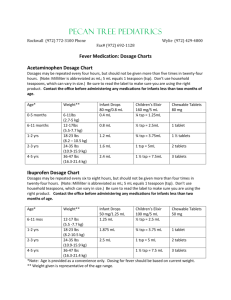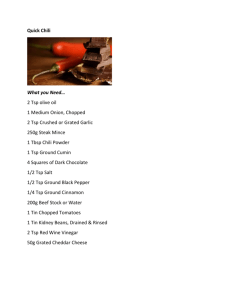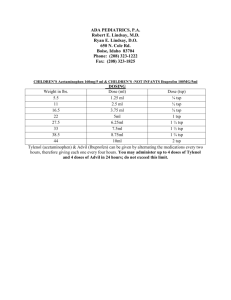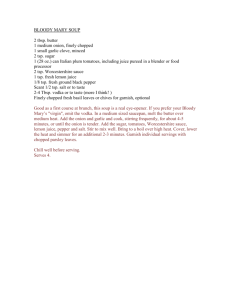Document 13310474
advertisement
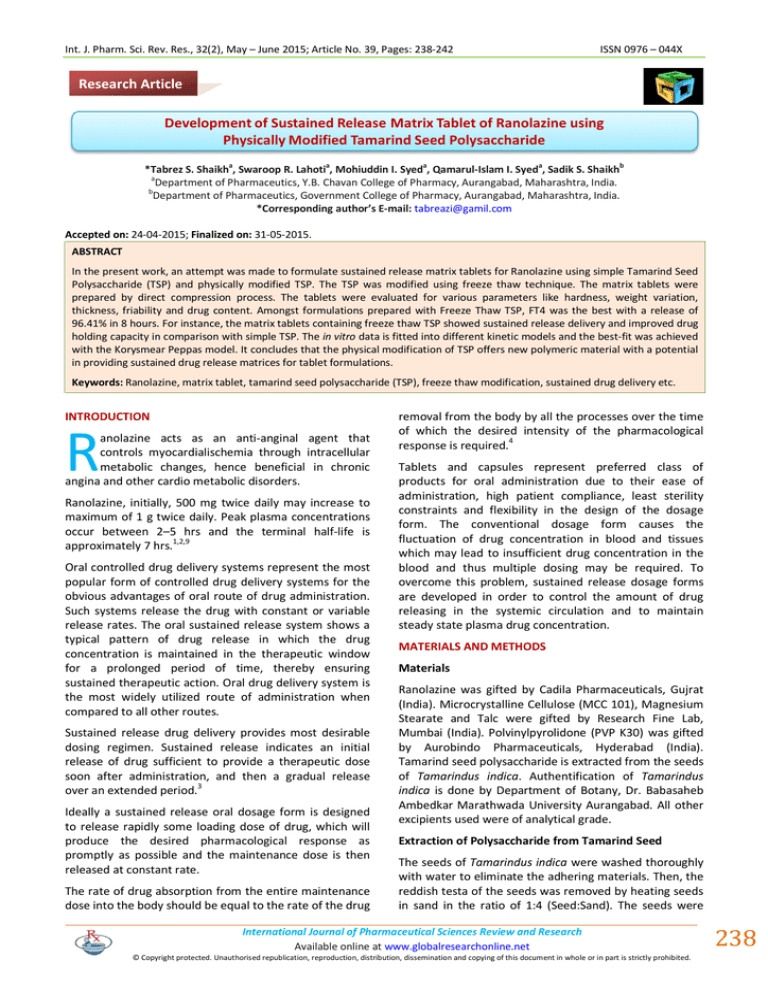
Int. J. Pharm. Sci. Rev. Res., 32(2), May – June 2015; Article No. 39, Pages: 238-242 ISSN 0976 – 044X Research Article Development of Sustained Release Matrix Tablet of Ranolazine using Physically Modified Tamarind Seed Polysaccharide a a a a b *Tabrez S. Shaikh , Swaroop R. Lahoti , Mohiuddin I. Syed , Qamarul-Islam I. Syed , Sadik S. Shaikh a Department of Pharmaceutics, Y.B. Chavan College of Pharmacy, Aurangabad, Maharashtra, India. b Department of Pharmaceutics, Government College of Pharmacy, Aurangabad, Maharashtra, India. *Corresponding author’s E-mail: tabreazi@gamil.com Accepted on: 24-04-2015; Finalized on: 31-05-2015. ABSTRACT In the present work, an attempt was made to formulate sustained release matrix tablets for Ranolazine using simple Tamarind Seed Polysaccharide (TSP) and physically modified TSP. The TSP was modified using freeze thaw technique. The matrix tablets were prepared by direct compression process. The tablets were evaluated for various parameters like hardness, weight variation, thickness, friability and drug content. Amongst formulations prepared with Freeze Thaw TSP, FT4 was the best with a release of 96.41% in 8 hours. For instance, the matrix tablets containing freeze thaw TSP showed sustained release delivery and improved drug holding capacity in comparison with simple TSP. The in vitro data is fitted into different kinetic models and the best-fit was achieved with the Korysmear Peppas model. It concludes that the physical modification of TSP offers new polymeric material with a potential in providing sustained drug release matrices for tablet formulations. Keywords: Ranolazine, matrix tablet, tamarind seed polysaccharide (TSP), freeze thaw modification, sustained drug delivery etc. INTRODUCTION R anolazine acts as an anti-anginal agent that controls myocardialischemia through intracellular metabolic changes, hence beneficial in chronic angina and other cardio metabolic disorders. Ranolazine, initially, 500 mg twice daily may increase to maximum of 1 g twice daily. Peak plasma concentrations occur between 2–5 hrs and the terminal half-life is approximately 7 hrs.1,2,9 Oral controlled drug delivery systems represent the most popular form of controlled drug delivery systems for the obvious advantages of oral route of drug administration. Such systems release the drug with constant or variable release rates. The oral sustained release system shows a typical pattern of drug release in which the drug concentration is maintained in the therapeutic window for a prolonged period of time, thereby ensuring sustained therapeutic action. Oral drug delivery system is the most widely utilized route of administration when compared to all other routes. Sustained release drug delivery provides most desirable dosing regimen. Sustained release indicates an initial release of drug sufficient to provide a therapeutic dose soon after administration, and then a gradual release over an extended period.3 Ideally a sustained release oral dosage form is designed to release rapidly some loading dose of drug, which will produce the desired pharmacological response as promptly as possible and the maintenance dose is then released at constant rate. The rate of drug absorption from the entire maintenance dose into the body should be equal to the rate of the drug removal from the body by all the processes over the time of which the desired intensity of the pharmacological response is required.4 Tablets and capsules represent preferred class of products for oral administration due to their ease of administration, high patient compliance, least sterility constraints and flexibility in the design of the dosage form. The conventional dosage form causes the fluctuation of drug concentration in blood and tissues which may lead to insufficient drug concentration in the blood and thus multiple dosing may be required. To overcome this problem, sustained release dosage forms are developed in order to control the amount of drug releasing in the systemic circulation and to maintain steady state plasma drug concentration. MATERIALS AND METHODS Materials Ranolazine was gifted by Cadila Pharmaceuticals, Gujrat (India). Microcrystalline Cellulose (MCC 101), Magnesium Stearate and Talc were gifted by Research Fine Lab, Mumbai (India). Polvinylpyrolidone (PVP K30) was gifted by Aurobindo Pharmaceuticals, Hyderabad (India). Tamarind seed polysaccharide is extracted from the seeds of Tamarindus indica. Authentification of Tamarindus indica is done by Department of Botany, Dr. Babasaheb Ambedkar Marathwada University Aurangabad. All other excipients used were of analytical grade. Extraction of Polysaccharide from Tamarind Seed The seeds of Tamarindus indica were washed thoroughly with water to eliminate the adhering materials. Then, the reddish testa of the seeds was removed by heating seeds in sand in the ratio of 1:4 (Seed:Sand). The seeds were International Journal of Pharmaceutical Sciences Review and Research Available online at www.globalresearchonline.net © Copyright protected. Unauthorised republication, reproduction, distribution, dissemination and copying of this document in whole or in part is strictly prohibited. 238 © Copyright pro Int. J. Pharm. Sci. Rev. Res., 32(2), May – June 2015; Article No. 39, Pages: 238-242 ISSN 0976 – 044X crushed and soaked in water separately for 24 hrs with 1% (w/v) of sodium meta-bisulphate and then boiled for 1 hr and kept aside for 2 hrs for the release of mucilage into water. The soaked seeds were taken and squeezed in a muslin bag to remove marc from the filtrate. The resulting thin clear solution was kept overnight so that most of the proteins and fibers settled out. The solution was then centrifuged at 5000 rpm for 20 minutes. The supernatant was separated and poured into twice the volume of absolute ethanol or equal quantity of acetone by continuous stirring to precipitate the mucilage. The mucilage was separated. The separated mucilage was dried at temperature 50°C, powdered and passed through sieve number 80. The dried mucilage was powdered and stored in airtight container at room temperature.5,6,14 rpm. A Vernier calipers (Remimoters, Mumbai) was used to measure the thickness for 5 tablets. Weight variation test was performed by taking 20 tablets using a Digital Weighing Balance (Shimadzu AX200, Japan). Purification of Polysaccharide In vitro Drug Release The precipitate obtained in extraction is dissolved in water and reprecipitate by acetone/ethanol. Same procedure is repeated for three times. After purification the polysaccharide powder is subjected to drying at 45°C and stored in a closed container.14 Drug release study was carried out in USP paddle type dissolution test apparatus. Dissolution medium was phosphate buffer pH 6.8. Volume of dissolution medium was 900 ml and bath temperature was maintained at 37 ± 0.5°C throughout the study. After each hr, 5 ml sample was withdrawn and analyzed for Ranolazine content by UV- spectrophotometer at 276 nm. Selected all optimized formulations dissolution was carried out in USP paddle type dissolution test apparatus, dissolution medium was0.1 N HCl for initial 2 hrs and then dissolution was carried out in phosphate buffer pH 6.8. The selection of obtained the in vitro data of dissolution study. Formulated tablets of modified TSP with different Drug: Modified polymer ratio. Modification of TSP by Freeze Thaw Method The tamarind seed polysaccharide is weight accurately and appropriate volume of water is added, mixed well and kept in deep freeze at -18°C for time interval of 8 hrs and 8 hrs in room temperature. This cycle is repeated for 6 times. The obtain sample is triturate after completing room temperature cycle. Sample is triturate in mortar pestle, and sieve thorough mesh No. 16. This modified polymer is use in making tablet.7,8,10 Preparation of Matrix Tablets Tablets were prepared by wet granulation method. Different batches of tablets, FT1 to FT5 were prepared by varying the concentration of TSP and MCC as shown (Table 1). The (Drug:TSP) polymer ratio was taken 1:0.2, 1:0.4, 1:0.6, 1:0.1,1:0.1 respectively. Batch FT5 formulated without PVP K30.All the excipients with drug except Mg Stearate were passed through 100# sieve and mixed uniformly. Add 5% PVP K30 solution as granulating agent to form damp mass. Damp mass was passed through mesh No. 18 and the collected wet granules were dried at 40°C. The dried granules were sized by a mesh No. 25 and mixed with Mg Stearate. Formulation was compressed by using Karnavati multi punch tableting machine having punch size 13 mm. All the formulations were stored in desiccator at room temperature for further study. Physical Characterization of Matrix Tablets The formulated tablets were evaluated for hardness, weight variation, thickness, friability and drug content. Hardness of matrix tablets from each formulation was measured using Hardness tester (Monsanto Hardness tester, Coslab Pvt. Ltd, Mumbai). Friability of the tablets was determined using 10 tablets in a Friability test apparatus EF-2 (USP) (Electro-lab Mumbai) for 4 min at 25 Drug Content Tablets were powdered in a mortar, transferred to a volumetric flask with distilled water, mixed in a mechanical shaker for 4 hrs and sufficient amount of distilled water was added to make 100 ml. This solution was filtered through a quantitative filter paper and aliquots of 0.1 ml were transferred to volumetric flasks and their volumes adjusted to 10 ml with distilled water. Absorbance was measured at 276 nm using UV spectrophotometer (Shimadzu 1800, Japan). Release Kinetics The dissolution profile of all the batches were fitted to zero order kinetic, best fitted model is Korsmeyer Peppas to as certain the kinetic modeling of drug release by using a PCP Disso V3 software, and the model with the higher correlation coefficient was considered to be the best model. In order to know the drug release mechanism the data was further analyzed by Korsmeyer equation and the value of n i.e. release exponent was calculated. Then value is used to interpret the release mechanism.11,12,16 Stability Study Stability studies were performed on batch FT 4. After stability studies tablets were removed at various time intervals and evaluated. RESULTS AND DISCUSSION Physical Characterization of Matrix Tablets The tablets of the proposed formulations (FT1 to FT5) were evaluated (Table 2) for hardness, weight variation, thickness, friability and drug content. The mean thickness (n=5) of the tablets were ranged from 7.1 to 7.5 mm. The mean hardness (n=3) and percentage friability of the tablets of all batches ranged from 4.1 to 4.5 kg/cm2 and 1.0% to 1.5%, respectively. The average percentage weight deviation of 20 tablets of each formulation was International Journal of Pharmaceutical Sciences Review and Research Available online at www.globalresearchonline.net © Copyright protected. Unauthorised republication, reproduction, distribution, dissemination and copying of this document in whole or in part is strictly prohibited. 239 © Copyright pro Int. J. Pharm. Sci. Rev. Res., 32(2), May – June 2015; Article No. 39, Pages: 238-242 less than ± 5%. Mean drug content of different batches ranged from 92%to 96%. In vitro Drug Release Study Effect of TSP and its modification on drug release of matrix tablet formulation is shown (Table 3). This polymer has been well known to retard the drug release by swelling in aqueous media. A polymer’s ability to retard the drug release rate is ISSN 0976 – 044X related to its viscosity. Processing factors including particle size, hardness, porosity and compressibility index etc. also can affect the release rate of drug from tablets. Modification of TSP by Freeze Thaw Method The Scanning Electron Microscope image for pure TSP particles topography show irregular shapes, smooth surface with no sharp edges. In case of freeze-thaw TSP particles topography show irregular shapes, smooth surface with sharp edges (Figure 1). Figure 1: Comparison of SEM images of Simple and Freeze Thaw TSP Figure 2: Zero order plot of Ranolazine release from matrix tablets using Freeze Thaw TSP Figure 3: Korysmear’s plot of Ranolazine release from matrix tablets using Freeze Thaw TSP Table 1: Composition of Ranolazine Matrix Tablets Ingredients FT1 FT2 FT3 FT4 FT5 Ranolazine 500 500 500 500 500 TSP 150 250 300 50 50 MCC 101 185 85 35 100 120 PVP K30 20 20 20 10 --- Mg-Stearate 10 10 10 10 10 Talc 5 5 5 5 5 International Journal of Pharmaceutical Sciences Review and Research Available online at www.globalresearchonline.net © Copyright protected. Unauthorised republication, reproduction, distribution, dissemination and copying of this document in whole or in part is strictly prohibited. 240 © Copyright pro Int. J. Pharm. Sci. Rev. Res., 32(2), May – June 2015; Article No. 39, Pages: 238-242 ISSN 0976 – 044X Table 2: Physical Evaluation of Matrix Tablets Batch Thickness (mm) Hardness (kg/cm2) Friability (%) Wt. Variation (%) Drug content (%) FT 1 7.1 ±0.16 4.1 ± 0.12 1.0 ± 0.25 0.15 96 ± 0.12 FT 2 7.2 ±0.19 4.5 ± 0.48 1.5 ± 0.34 -0.44 94 ± 0.51 FT 3 7.3 ±0.13 4.3 ± 0.47 1.1 ± 0.24 -0.76 92 ± 0.78 FT 4 7.2 ±0.15 4.1 ± 0.12 1.0 ± 0.25 -0.76 96 ± 0.12 FT 5 7.5 ± 0.24 4.5 ± 0.48 1.5 ± 0.34 0.15 94 ± 0.51 Table 3: In vitro drug release for all formulations. Time (hrs) FT 1 FT 2 FT 3 FT 4 FT 5 0 0 0 0 0 0 0.5 5.1 ± 0.25 4.12 ± 0.14 5.14 ± 0.11 4.1 ± 0.25 5.12 ± 0.14 1 7.1 ± 0.21 10.1 ± 0.12 10.01 ± 0.16 10.1 ± 0.21 12.1 ± 0.12 2 21 ± 0.41 14.7 ± 0.11 21.0 ± 0.24 21.0± 0.41 16.7 ± 0.11 3 26 ± 0.46 20.9 ± 0.14 41.0 ± 0.45 36.0± 0.46 23.9 ± 0.14 4 39 ± 0.51 51.01 ± 0.12 53.1 ± 0.19 49.0± 0.51 66.1 ± 0.12 5 56 ± 0.47 61.1 ± 0.26 72.1 ± 0.78 61.0± 0.47 71.1 ± 0.26 6 62 ± 0.12 72.0± 0.24 79.7 ± 0.21 72.0± 0.35 82.7 ± 0.84 7 71 ± 0.35 79.7 ± 0.84 81.45 ± 0.9 81.0± 0.27 89.7 ± 0.19 8 89 ± 0.27 86.7 ± 0.19 90.0 ± 0.7 96.5 ± 0.18 92.5 ± 0.14 Table 4: Comparison of some Physical Properties of Simple TSP and Freeze Thaw TSP. Observation Properties Simple TSP Freeze Thaw TSP Viscosity (5% Solution) 917.3 centipoise 218.1 centipoise Color Cream Cream to Light grey pH 6.81 ± 0.21 6.83 ± 0.17 Solubility Sparingly soluble in cold water Soluble in DMSO and THF Bulk density 0.545 ± .012 0.560 ± 0.10 Bulkiness 1.854 ± 0.042 1.785 ± 0.040 Tapped density 0.666 ± .051 0.595 ± 0.02 Compressibility index 18.168 ± 0.11 19.25 ± 0.10 Angle of repose 32° 31.64° Particle size 80-120 µm 84-126 µm Table 5: Release kinetics of formulated Ranolazine from different proportion of Freeze Thaw TSP. Batch Zero Order R 2 First Order R 2 Higuchi R 2 Korsmeyer Peppas R 2 Hixson Crowell R 2 FT 1 0.9906 0.8704 0.8970 0.9822 0.8464 FT 2 0.9714 0.9479 0.8830 0.8736 0.8538 FT 3 0.9746 0.9704 0.9315 0.9554 0.8114 FT 4 0.9980 0.8135 0.9223 0.9973 0.8368 FT 5 0.9460 0.9468 0.8798 0.7865 0.8305 International Journal of Pharmaceutical Sciences Review and Research Available online at www.globalresearchonline.net © Copyright protected. Unauthorised republication, reproduction, distribution, dissemination and copying of this document in whole or in part is strictly prohibited. 241 © Copyright pro Int. J. Pharm. Sci. Rev. Res., 32(2), May – June 2015; Article No. 39, Pages: 238-242 ISSN 0976 – 044X There are some changes in rheological and physical characteristics of TSP (Table 4) like viscosity, bulk density, bulkiness, tapped density, angle of repose, compressibility index, particle size etc. Mumbai (India) for their liberal contribution of drug and various excipients. The authors are also thankful to Dr. Babasaheb Ambedkar Marathwada University Aurangabad for authentification of plant species. Release Kinetics REFERENCES In order to investigate the drug release mechanism from tablet, the % cumulative drug release data was analyzed with the following mathematical models viz., Zero order (Figure 2), first order, Higuchi, Korsmeyer-Peppas (Figure 5) and Hixson-Crowell equations. Kinetic release patterns (in pH 6.8 Phosphate buffer solution) of formulations were studied by PCP Disso V3 and values were observed according to Table.5. 1. Bhandari B., Subramanian L., Recent Patent on Cardiovascular Drug Discovery, 2, 2007, 35-39. 2. Md. Mofizur Rahman, Sayeed Hasan, Md. Ashiqul Alam, Sumon Roy, Mithilesh Kumar Jha, Md. Qamrul Ahsan, Md. Habibur Rahman, Formulation and evaluation of Ranolazine sustained release matrix tablets using Eudragit and HPMC, International Journal of Pharmaceutical and Biomedical Research, 2(1), 2011, 7-12. 3. Aulton ME, Pharmaceutics: the Science of Dosage Form Design. 2nd edition, Nd Livingstone C. Elsevier Science Ltd, 2002, 315-320. 4. Uddin MN, Ishtiaq A, Monzurul AR, Islam MR, Rahman MH, Jalil R. In vitro Release Kinetics Study of Ranolazine from swellable hydrophilic matrix tablets. Journal of Pharmaceutical Sciences, 8(1), 2009, 31-38. 5. Gidley MJ,Peter JL, David WR, Structure and solution properties of tamarind-seed polysaccharide, Carbohydrate Research, 214, 1991, 299-314. 6. Rao PS, Srivastava HC, Tamarind in industrial gums, In Whistler RL. Academic Press, New York, Edition 2, 1973, 369-411. 7. Supaporn Sriwongsitanont, Ueno M, Effect of Freeze-Thawing Process on the Size and Lamellarity of PEG-Lipid Liposomes, The Open Colloid Science Journal, 4, 2011, 1-6. 8. M. Ueno, S. Sriwongsitanont, Effect of PEG lipid on fusion and fission of phospholipid vesicles in the process of freezethawing, Polymer, 46, 2005, 1257–1267. 9. Bernard RC, Ranolazine for the treatment of chronic angina and potential use in other cardiovascular conditions, American Heart Association Journals, 113, 2006, 2462-2472. Stability Study From stability studies it was observed that, there is no changes in physical appearance like colour, size, shape etc. Sustained release matrix tablet of Ranolazine was found to be stable at 40 ± 2°C and 75 ± 5% RH for 30 days. CONCLUSION Various analytical techniques such as FTIR, DSC, SEM study confirms the modification of TSP polysaccharide was done successfully and micromeritic evaluation showed fair-passable flow properties for TSP and excellent flow properties and compressibility for Freeze Thaw TSP. The physical mixture of Drug- polymer was found to be compatible as indicated by the FTIR studies. The order of increasing release retarding effect observed with polymers as follows; Freeze thaw method > Pure TSP. The amount of simple TSP required for sustained effect in tablets was 10 times more than that of modified TSP formulations thus use of Modified TSP particularly those prepared by Freeze-Thaw would prove more effective drug release retardants. Drug holding capacity of tamarind seed polymer was increased by six times. Amongst formulations prepared with Freeze Thaw TSP, FT4 was the best with a release of 96.41% in 8 hours. FT4 Formulation follows Peppas model for sustained release in 0.1N HCl for 2 hrs and followed by pH 6.8 phosphate buffer solution. Stability study also proves that formulation was stable. Finally, it is concluded that the physical modification of TSP polysaccharide obtained from seed of Tamarindus indica offers new polymeric material with properties that have a potential in providing sustained drug release matrices for tablet formulations. Future Prospective Toxicology profile of modified TSP polysaccharide needs to be confirmed. The in-vivo dissolution studies should be done followed by IVIVC studies. Acknowledgement: The authors are thankful to Cadila Pharmaceuticals, Gujrat (India) and Research Fine Lab, 10. Bhattacharya A, Grafting as a versatile means of modify polymers techniques, factors & applications, Progress in polymer science, 29, 2000, 767-814. 11. Brahmankar D.M, Jaiswal S.B. Biopharmaecutics and Pharmacokinetics. A Treatise, Vallabh Prakashan, New Delhi. 2, 2010, 39-50, 335-357, 399-400. 12. Gibaldi M. Biopharmaceutics and Clinical pharmacokinetics, Lea and Lebiger Malvern, Pennsylvania, 4, 1991, 124-135. 13. Indian Pharmacopoeia. Government of India. Ministry of health and Family Welfare. The controller of publications. New Delhi, 1996, 736. 14. Khandewal K.R. Pratical of Pharmacognosy, Techniques and experimental, Nirali prakashna, 2006, 149-155, 157-160. 15. Lachman L, Liberman HA, Kanig JL. The theory and Practice of Industrial pharmacy. Varghese publishing house: Mumbai. 3rd edition, 1990, 296-302. 16. Peppas N.A. Analysis of Fickian and non-Fickian drug release from polymers, Pharmaceutica Acta Helvetiae, 60(40), 1985, 110-111. 17. The United State Pharmacopoeia, United State Pharmacopoeial Convection, Rockville, MD. Asian edition. 2000, 1941-1943. Source of Support: Nil, Conflict of Interest: None. International Journal of Pharmaceutical Sciences Review and Research Available online at www.globalresearchonline.net © Copyright protected. Unauthorised republication, reproduction, distribution, dissemination and copying of this document in whole or in part is strictly prohibited. 242 © Copyright pro

